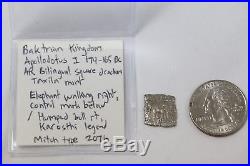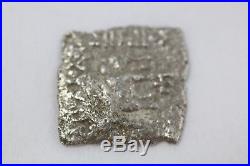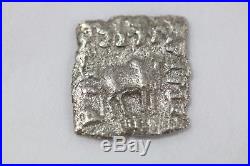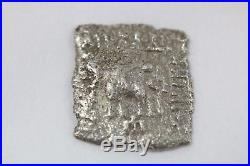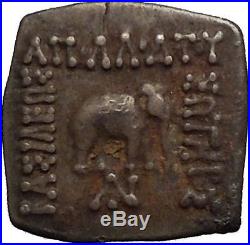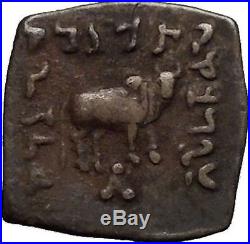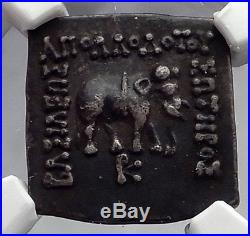
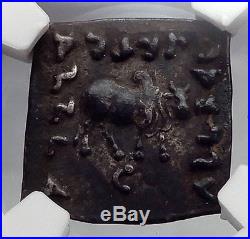
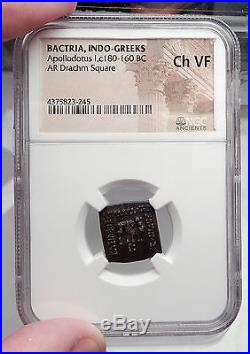
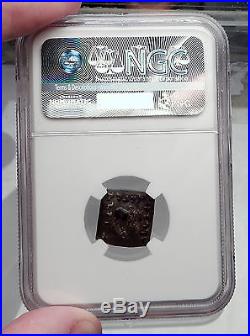

Item: i60166 Authentic Ancient Coin of. I ndo Greek Kingdom in India Apollodotos I – King: 174-165 B. Square Silver Drachm 20mm (1.38 grams) Mint in the Paropamisadai or Gandhara, circa 174-165 B. Reference: HGC 12, 119; Sear 7591; Mitchiner 207a; B. India 34,3 Certification: NGC Ancients Ch VF 4375823-245 Elephant standing right; behind, above, before; KP monogram beneath. “Of Saviour King Apollodotus”. Humped bull standing right, Bull with Kharoshti legend MAHARAJASA TRATARASA APALADATASA, “Saviour King Apollodotus”. Following the final defeat of Antimachos, Agathokles and Pantaleon, Eukratides appointed two sub-kings, Apollodotos and Menander, to administer the southern provinces of his realm. Apollodotus I Soter (Greek : , “Apollodotus the Saviour” , Sanskrit : maharajasa apaladatasa tratarasa) was an Indo-Greek king between 180 BCE and 160 BCE or between 174 and 165 BCE first dating Osmund Bopearachchi and R. Senior, second dating Boperachchi who ruled the western and southern parts of the Indo-Greek kingdom, from Taxila in Punjab to the areas of Sindh and possibly Gujarat. Ruler of the Indo-Greek kingdom. Apollodotus was not the first to strike bilingual coins outside of Bactria, but he was the first king who ruled in India only, and therefore the founder of the proper Indo-Greek kingdom. Tarn , Apollodotus I was one of the generals of Demetrius I of Bactria , the Greco-Bactrian king who invaded northwestern India after 180 BCE. Tarn was uncertain whether he was a member of the royal house. Later authors largely agree with Tarn’s analysis, though with perhaps even more uncertainty regarding who the king was, for his coins do not give many hints. Apollodotus was either succeeded in India by Antimachus II , or the two kings were contemporary, Antimachus II ruling the more western territories closer to Bactria. Eventually Apollodotus I was succeeded by Menander I , and the two kings are mentioned by Pompejus Trogus as important Indo-Greek rulers. The 1st-2nd century CE Periplus of the Erythraean Sea further testifies to the reign of Apollodotus I and the influence of the Indo-Greeks in India. To the present day ancient drachmae are current in Barygaza , coming from this country, bearing inscriptions in Greek letters, and the devices of those who reigned after Alexander, Apollodorus [sic] and Menander. The coinage of Apollodotus is, together with that of Menander, one of the most abundant of the Indo-Greek kings. It is found mainly in the provinces of Punjab, Sindh and Gujarat , indicating the southern limit of the Indo-Greek expansion in India. This is also suggested by the Periplus , a 1st century CE document on trade in the Indian Ocean , which describes the remnants of Greek presence (shrines, barracks, wells, coinage) in the strategic port of Barygaza (Bharuch) in Gujarat. Strabo (XI) also describes the occupation of Patalene (Indus Delta country). While Sindh may have come under his possession, it is not known as to whether Apollodotus advanced to Gujarat, where the Satavahanas ruled. Apollodotus also issued a great number of bilingual Indian-standard square coins. Beside the usual royal title, the exact significance of the animals depicted on the coins is unclear. The sacred elephant may be the symbol of the city of Taxila , or possibly the symbol of the white elephant who reputedly entered in dream the womb the mother of the Buddha , Queen Maya , which would make it a symbol of Buddhism , one of the main religions of the Indo-Greek territories. Similarly, the sacred bull on the reverse may be a symbol of a city (Pushkhalavati), or a depiction of Shiva , making it a symbol of Hinduism , the other major religion at that time. The bull is often represented in a clearly erectile state, which reinforces its interpretation as a representation of Shiva. Conversely, this also reinforces the interpretation of the elephant as a religious symbol. Alternatively, the Bull, according to Foucher , represents the birth of the Buddha, as it happened during the month of Vaicakha (AprilMay), known to Buddhists as Vesak , under the zodiacal sign of the Taurus , during the full moon. The enlightenment and passing of the Buddha also occurred during the Taurus full moon. Before their design was eventually simplified, some of the earlier coins of king Apollodotus directly associate the elephant with Buddhist symbolism, such as the stupa hill surmounted by a star, also seen, for example on the coins of the Mauryan Empire or those of the later Kuninda kingdom. Apollodotus experimented with different coin standards for his silver, until he settled for a standard lighter than the Attic which would prevail for centuries, though later rulers usually struck round coins instead of the square (typically Indian) shape of most of Apollodotus’ silver. He issued a number of bronzes with Apollo /tripod, that also were repeated for centuries. Apollodotus also issued a small series of monolingual Attic tetradrachms, intended for export into Bactria. For these, Apollodotus I clearly used Bactrian celators to strike an exquisite realistic portrait of the king as an aged man in the Macedonian hat called kausia, with a reverse of sitting Pallas Athene holding Nike , a common Hellenistic motif introduced by the Diadoch Lysimachusus. On these coins, he used no epithet. Preceded by: (In Paropamisade) Agathocles (In Gandhara) Pantaleon. Indo-Greek Ruler (Paropamisade , Arachosia , Gandhara , Punjab) 180160 BCE. Succeeded by: Antimachus II. Ilya Zlobin, world-renowned expert numismatist, enthusiast, author and dealer in authentic ancient Greek, ancient Roman, ancient Byzantine, world coins & more. Ilya Zlobin is an independent individual who has a passion for coin collecting, research and understanding the importance of the historical context and significance all coins and objects represent. Send me a message about this and I can update your invoice should you want this method. Getting your order to you, quickly and securely is a top priority and is taken seriously here. Great care is taken in packaging and mailing every item securely and quickly. What is a certificate of authenticity and what guarantees do you give that the item is authentic? You will be very happy with what you get with the COA; a professional presentation of the coin, with all of the relevant information and a picture of the coin you saw in the listing. Additionally, the coin is inside it’s own protective coin flip (holder), with a 2×2 inch description of the coin matching the individual number on the COA. Whether your goal is to collect or give the item as a gift, coins presented like this could be more prized and valued higher than items that were not given such care and attention to. Is there a number I can call you with questions about my order? When should I leave feedback? Please don’t leave any negative feedbacks, as it happens sometimes that people rush to leave feedback before letting sufficient time for their order to arrive. The matter of fact is that any issues can be resolved, as reputation is most important to me. My goal is to provide superior products and quality of service. How and where do I learn more about collecting ancient coins? Visit the “Guide on How to Use My Store” for on an overview about using my store, with additional information and links to all other parts of my store which may include educational information on topics you are looking for. You may also want to do a YouTube search for the term “ancient coin collecting” for educational videos on this topic. The item “APOLLODOTOS I 174BC Ancient Greek India Bull Elephant Silver Coin NGC i60166″ is in sale since Sunday, March 19, 2017. This item is in the category “Coins & Paper Money\Coins\ Ancient\Greek (450 BC-100 AD)”. The seller is “highrating_lowprice” and is located in Rego Park, New York. This item can be shipped worldwide.
- Composition: Silver
- Certification: NGC
- Culture: Greek
- Material: Silver
- Coin Type: Ancient
- Certification Number: 4375823-245
- Grade: Ch VF

